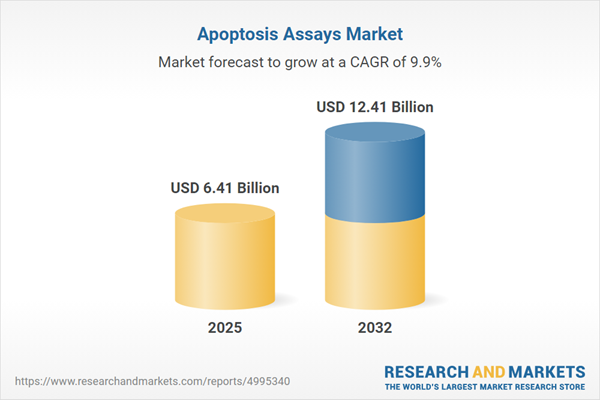Speak directly to the analyst to clarify any post sales queries you may have.
The Apoptosis Assays Market is experiencing steady evolution, fueled by advances in cellular analysis, the growing need for sensitive detection methods in life sciences, and operational shifts driven by global supply chain dynamics. As industry standards advance, decision-makers recognize the value of robust, adaptable assay platforms that address emerging research and regulatory demands.
Market Snapshot: Apoptosis Assays Market Growth and Scale
The Apoptosis Assays Market grew from USD 5.82 billion in 2024 to USD 6.41 billion in 2025. It is expected to continue growing at a CAGR of 9.91%, reaching USD 12.41 billion by 2032. This expansion is propelled by increased adoption in cancer research, immunology, drug development, and the need for high-content cell death analysis technologies across multiple regions.
Scope & Segmentation
This report covers a comprehensive spectrum of the apoptosis assay landscape and its evolving technologies. The segmentation enables targeted analysis of the following:
- Product Type: Instruments such as flow cytometers (benchtop and high throughput), imaging systems (fluorescence and high content platforms), and microplate readers (absorbance, fluorescence, luminescence). Reagents encompass consumables and assay kits for optimal workflow integration.
- Assay Type: Includes colorimetric, enzyme-linked immunosorbent, flow cytometry-based, fluorometric, and luminescent formats for endpoint and kinetic analysis.
- Application: Encompasses cancer research, drug screening, immunology, and neurodegenerative disease analysis, supporting both basic research and clinical advancements.
- End User: Academic research institutes, contract research organizations, hospitals and diagnostic laboratories, pharmaceutical and biotechnology companies.
- Label Technology: Colorimetric, fluorescent, and luminescent labels tailored for sensitivity, multiplexing, and compatibility with emerging instrumentation.
- Regional Analysis: Covers Americas (North America, Latin America), Europe, Middle East & Africa (with granular country-level insights), and Asia-Pacific. Regional focus ensures localization strategies align with local manufacturing capabilities, regulatory frameworks, and user needs.
- Company Profiling: Examines leaders and innovators such as Thermo Fisher Scientific Inc., Merck KGaA, Promega Corporation, Abcam plc, Bio-Rad Laboratories, Inc., PerkinElmer, Becton, Dickinson and Company, F. Hoffmann-La Roche Ltd., Agilent Technologies, Inc., and Qiagen N.V.
Key Takeaways for Decision-Makers
- Technological innovation is reshaping both instrument design and reagent chemistries, yielding greater sensitivity and throughput while minimizing hands-on time for researchers.
- Integrated imaging and digital analytics tools are streamlining complex data interpretation, offering predictive modeling and supporting standardized workflows in global research environments.
- Market dynamics in the Americas and Asia-Pacific reflect robust investment in R&D infrastructure, automation, and digital solutions, while Europe, Middle East, and Africa face nuanced regulatory considerations and increasing regional manufacturing efforts.
- Strategic partnerships—spanning academic, contract research, and commercial entities—accelerate assay validation and protocol harmonization, reducing barriers to product adoption and fostering resource efficiency.
- Segment-specific product development enables companies to align offerings with end-user requirements in oncology, immunology, and neurodegenerative research, optimizing market positioning.
United States Tariff Impact: Supply Chain and Innovation Considerations
The implementation of tariffs on laboratory instruments and reagents in 2025 is influencing purchasing strategies, with organizations shifting toward local sourcing, regional manufacturing partnerships, and supply chain realignment. Collaborative procurement, strategic alliances, and supplier diversification help mitigate disruption and enable continuity in critical research activities. Agile procurement frameworks and contingency planning are essential to maintain progress amid duty fluctuations and regulatory changes.
Methodology & Data Sources
This report leverages in-depth interviews with academic and industry leaders, secondary research from peer-reviewed literature, and robust data triangulation. Quantitative analysis of product pipelines, competitive benchmarking, tariff policy reviews, and expert panel validation deliver a balanced perspective on the market's evolution.
Why This Report Matters
- Enables informed decisions on technology adoption and market entry by providing actionable segmentation insights and competitor benchmarking.
- Equips organizations with strategic guidance to manage regulatory shifts, supply chain risks, and evolving research demands across global regions.
Conclusion
This analysis equips stakeholders with a clear understanding of the apoptosis assays market, revealing the interplay of technology, regulation, and segmentation. Strategic insights provided will help optimize procurement, partnership, and innovation strategies to meet evolving scientific and operational requirements.
Additional Product Information:
- Purchase of this report includes 1 year online access with quarterly updates.
- This report can be updated on request. Please contact our Customer Experience team using the Ask a Question widget on our website.
Table of Contents
3. Executive Summary
4. Market Overview
7. Cumulative Impact of Artificial Intelligence 2025
Companies Mentioned
The companies profiled in this Apoptosis Assays market report include:- Thermo Fisher Scientific Inc.
- Merck KGaA
- Promega Corporation
- Abcam plc
- Bio-Rad Laboratories, Inc.
- PerkinElmer, Inc.
- Becton, Dickinson and Company
- F. Hoffmann-La Roche Ltd.
- Agilent Technologies, Inc.
- Qiagen N.V.
Table Information
| Report Attribute | Details |
|---|---|
| No. of Pages | 192 |
| Published | October 2025 |
| Forecast Period | 2025 - 2032 |
| Estimated Market Value ( USD | $ 6.41 Billion |
| Forecasted Market Value ( USD | $ 12.41 Billion |
| Compound Annual Growth Rate | 9.9% |
| Regions Covered | Global |
| No. of Companies Mentioned | 11 |









